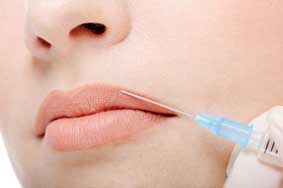 According to a recent study by the American Society for Aesthetic Plastic Surgery, there were nearly 2 million hyaluronic acid filler injections performed in 2015. With immediate rejuvenating results and little-to-no downtime, why not have filler?
According to a recent study by the American Society for Aesthetic Plastic Surgery, there were nearly 2 million hyaluronic acid filler injections performed in 2015. With immediate rejuvenating results and little-to-no downtime, why not have filler?
Here are 6 truths about fillers you’ll wish your dermatologist told you:
1. You can have too much of a good thing. So…it softened your nasolabial folds (the lines connecting the corner of your lips to the outside of your nostrils). It muted your marionette lines (the lines heading south from the corners of your mouth). Now, why not plump up your cheeks? Well, you can….sort of…. But just like a Hervé Léger bandage dress, you need to have the right underlying bone structure. If not, watch out or meet Ms. Bobblehead!
2. It’s not what you use, it’s how you use it! Juvederm? Restylane? Voluma? Does it really make a difference which hyaluronic acid filler you choose? While some docs prefer one or another, most will agree that it’s not which one is used, but how and where it is placed. For lips, filler should be injected where the pink part and white part connect, not in the pink, fleshy part causing unnatural lumps and bumps. For the nasolabial folds, marionette lines, and cheeks, filler placed too superficial will be visible through the skin, and filler put too deep will cause you to spend more and see less!
3. Cheek filler is like pregnancy. It lasts about 9-10 months. In injected cheeks, like an expecting belly, gravity continues to wreak havoc, and aging cheek skin (stretched with filler) continues to droop. Filler has limited hoisting potential so woe be the one who refuses surgery (when the time is right). There is a point of no return when no additional filler can do the trick.
4. You don’t need a facelift to get rid of early jowls. Good news! A bit of perfectly placed filler can eliminate jowls and return your jawline to its youthful, superhero vigor.
5. Filler here. Filler there. Filler, filler everywhere? Yes, filler can be used in the chin crease and even in the tear trough (the diagonal and indented pathway down which tears flow). However, fillers should not be injected in the “11” lines in the forehead, unless the area is first immobilized with Botox or Dysport, and, then, only if the line remains visible. If not, filler will tend to move with muscle motion and clump in a visible location.
6. Forego the facials and avoid a breakdown. While having a facial can be a great was to melt away stress and tension, extended facial massage (and radio frequency tightening treatments) can breakdown filler and make it go away faster. Tell your facialist about the location(s) of your filler to improve its life expectancy at the same time!































